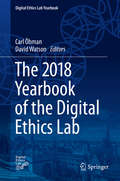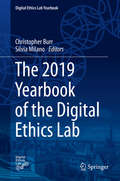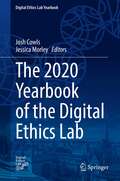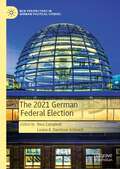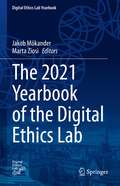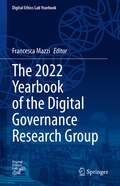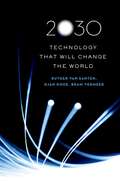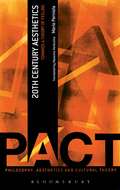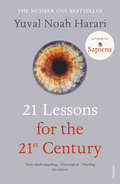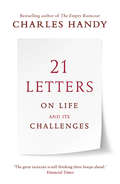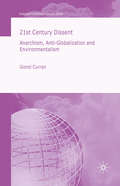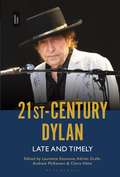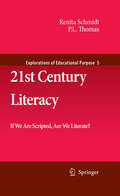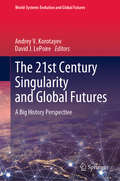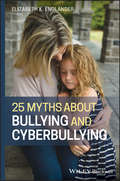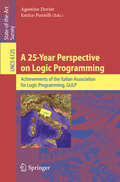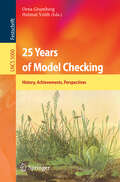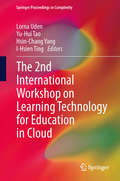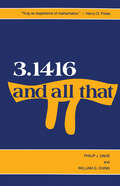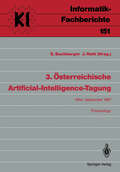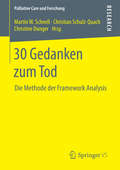- Table View
- List View
The 2018 Yearbook of the Digital Ethics Lab (Digital Ethics Lab Yearbook #1)
by Carl Öhman David WatsonThis book explores a wide range of topics in digital ethics. It features 11 chapters that analyze the opportunities and the ethical challenges posed by digital innovation, delineate new approaches to solve them, and offer concrete guidance to harness the potential for good of digital technologies. The contributors are all members of the Digital Ethics Lab (the DELab), a research environment that draws on a wide range of academic traditions.The chapters highlight the inherently multidisciplinary nature of the subject, which cannot be separated from the epistemological foundations of the technologies themselves or the political implications of the requisite reforms. Coverage illustrates the importance of expert knowledge in the project of designing new reforms and political systems for the digital age. The contributions also show how this task requires a deep self-understanding of who we are as individuals and as a species.The questions raised here have ancient -- perhaps even timeless -- roots. The phenomena they address may be new. But, the contributors examine the fundamental concepts that undergird them: good and evil, justice and truth. Indeed, every epoch has its great challenges. The role of philosophy must be to redefine the meaning of these concepts in light of the particular challenges it faces. This is true also for the digital age. This book takes an important step towards redefining and re-implementing fundamental ethical concepts to this new era.
The 2019 Yearbook of the Digital Ethics Lab (Digital Ethics Lab Yearbook)
by Christopher Burr Silvia MilanoThis edited volume presents an overview of cutting-edge research areas within digital ethics as defined by the Digital Ethics Lab of the University of Oxford. It identifies new challenges and opportunities of influence in setting the research agenda in the field.The yearbook presents research on the following topics: conceptual metaphor theory, cybersecurity governance, cyber conflicts, anthropomorphism in AI, digital technologies for mental healthcare, data ethics in the asylum process, AI’s legitimacy and democratic deficit, digital afterlife industry, automatic prayer bots, foresight analysis and the future of AI. This volume appeals to students, researchers and professionals.
The 2020 Yearbook of the Digital Ethics Lab (Digital Ethics Lab Yearbook)
by Josh Cowls Jessica MorleyThis annual edited volume presents an overview of cutting-edge research areas within digital ethics as defined by the Digital Ethics Lab of the University of Oxford. It identifies new challenges and opportunities of influence in setting the research agenda in the field. The 2020 edition of the yearbook presents research on the following topics: governing digital health, visualising governance, the digital afterlife, the possibility of an AI winter, the limits of design theory in philosophy, cyberwarfare, ethics of online behaviour change, governance of AI, trust in AI, and Emotional Self-Awareness as a Digital Literacy. This book appeals to students, researchers and professionals in the field.
The 2021 German Federal Election (New Perspectives in German Political Studies)
by Ross Campbell Louise K. Davidson-SchmichThe German Federal Election of 2021 was one of the most open and competitive in the post-war era. This book provides a systematic analysis of its domestic and international context, the shifting balance of the political parties, the election strategies and campaign themes, along with the challenges of government formation. An international array of scholars from Europe, North America and Australasia have contributed specially commissioned chapters on their principal areas of research. The discussion of individual topics is combined with sufficient background information so as to be accessible to readers who may not have detailed knowledge of German politics. In addition, by including links to multimedia election-related content we enhance the value of this volume and make it an indispensable reference tool.
The 2021 Yearbook of the Digital Ethics Lab (Digital Ethics Lab Yearbook)
by Jakob Mökander Marta ZiosiThis annual edited volume explores a wide range of topics in digital ethics and governance. Included are chapters that: analyze the opportunities and ethical challenges posed by digital innovation; delineate new approaches to solve them; and offer concrete guidance on how to govern emerging technologies. The contributors are all members of the Digital Ethics Lab (the DELab) at the Oxford Internet Institute, a research environment that draws on a wide range of academic traditions. Collectively, the chapters of this book illustrate how the field of digital ethics - whether understood as an academic discipline or an area of practice - is undergoing a process of maturation. Most importantly, the focus of the discourse concerning how to design and use digital technologies is increasingly shifting from ‘soft ethics’ to ‘hard governance’. Then, there is the trend in the ongoing shift from ‘what’ to ‘how’, whereby abstract or ad-hoc approaches to AI governance are giving way to more concrete and systematic solutions. The maturation of the field of digital ethics has, as this book attempts to show, been both accelerated and illustrated by a series of recent events. This text thereby takes an important step towards defining and implementing feasible and effective approaches to digital governance. It appeals to students, researchers and professionals in the field.
The 2022 Yearbook of the Digital Governance Research Group (Digital Ethics Lab Yearbook)
by Francesca MazziThis annual edited volume presents an overview of cutting-edge research areas within digital ethics as defined by the Digital Governance Research Group of the University of Oxford. It identifies new challenges and opportunities of influence in setting the research agenda in the field.The 2022 edition of the Yearbook presents research on the following topics: autonomous weapons, cyber weapons, digital sovereignty, smart cities, artificial intelligence for the Sustainable Development Goals, vaccine passports, and sociotechnical pragmatism as an approach to technology. This text appeals to students, researchers, and professionals in the field.
2030: Technology That Will Change the World
by Rutger van Santen Djan Khoe Bram VermeerImagine living in 1958, and knowing that the integrated circuit--the microchip--was about to be invented, and would revolutionize the world. Or imagine 1992, when the Internet was about to transform virtually every aspect of our lives. Incredibly, this book argues that we stand at such a moment right now--and not just in one field, but in many. In 2030, authors Rutger van Santen, Djan Khoe, and Bram Vermeer interview over two dozen scientific and technological experts on themes of health, sustainability and communication, asking them to look forward to the year 2030 and comment on the kind of research that will play a necessary role. If we know what technology will be imperative in 2030, the authors reason, what can we do now to influence future breakthroughs? Despite working in dissimilar fields, the experts called upon in the book - including Hans Blix (Head of the UN investigation in Iraq), Craig Venter (explorer of the human DNA), and Susan Greenfield (a leading world authority on the human brain), among many others - all emphasize the interconnectedness of our global networks in technology and communication, so tightly knit that the world's major conflicts are never isolated incidents. A fresh understanding of the regularities underlying these complex systems is more important than ever. Using bright, accessible language to discuss topics of universal interest and relevance, 2030 takes the position that we can, in fact, influence the course of history. It offers a new way of looking forward, a fresh perspective on sustainability, stability and crisis-prevention. For anyone interested in modern science, this book will showcase the technologies that will soon change the way we live.
2030: Technology That Will Change the World
by Rutger van Santen Djan Khoe Bram VermeerImagine living in 1958, and knowing that the integrated circuit--the microchip--was about to be invented, and would revolutionize the world. Or imagine 1992, when the Internet was about to transform virtually every aspect of our lives. Incredibly, this book argues that we stand at such a moment right now--and not just in one field, but in many. In 2030, authors Rutger van Santen, Djan Khoe, and Bram Vermeer interview over two dozen scientific and technological experts on themes of health, sustainability and communication, asking them to look forward to the year 2030 and comment on the kind of research that will play a necessary role. If we know what technology will be imperative in 2030, the authors reason, what can we do now to influence future breakthroughs? Despite working in dissimilar fields, the experts called upon in the book - including Hans Blix (Head of the UN investigation in Iraq), Craig Venter (explorer of the human DNA), and Susan Greenfield (a leading world authority on the human brain), among many others - all emphasize the interconnectedness of our global networks in technology and communication, so tightly knit that the world's major conflicts are never isolated incidents. A fresh understanding of the regularities underlying these complex systems is more important than ever. Using bright, accessible language to discuss topics of universal interest and relevance, 2030 takes the position that we can, in fact, influence the course of history. It offers a new way of looking forward, a fresh perspective on sustainability, stability and crisis-prevention. For anyone interested in modern science, this book will showcase the technologies that will soon change the way we live.
20th Century Aesthetics: Towards A Theory of Feeling (Philosophy, Aesthetics and Cultural Theory)
by Mario PerniolaIn our contemporary age aesthetics seems to crumble and no longer be reducible to a coherent image. And yet given the vast amount of works in aesthetics produced in the last hundred years, this age could be defined “the century of aesthetics”. 20th Century Aesthetics is a new account of international aesthetic thought by Mario Perniola, one of Italy's leading contemporary thinkers. Starting from four conceptual fields – life, form, knowledge, action - Perniola identifies the lines of aesthetic reflection that derive from them and elucidates them with reference to major authors: from Dilthey to Foucault (aesthetics of life), from Wölfflin to McLuhan and Lyotard (aesthetics of form), from Croce to Goodman (aesthetics and knowledge), from Dewey to Bloom (aesthetics and action). There is also a fifth one that touches on the sphere of affectivity and emotionality, and which comes to aesthetics from thinkers like Freud, Heidegger, Wittgenstein, Lacan, Derrida and Deleuze. The volume concludes with an extensive sixth chapter on Japanese, Chinese, Indian, Islamic, Brazilian, South Korean and South East Asian aesthetic thought and on the present decline of Western aesthetic sensibility.
20th Century Aesthetics: Towards A Theory of Feeling (Philosophy, Aesthetics and Cultural Theory)
by Mario Perniola Massimo VerdicchioIn our contemporary age aesthetics seems to crumble and no longer be reducible to a coherent image. And yet given the vast amount of works in aesthetics produced in the last hundred years, this age could be defined "the century of aesthetics†?. 20th Century Aesthetics is a new account of international aesthetic thought by Mario Perniola, one of Italy's leading contemporary thinkers. Starting from four conceptual fields – life, form, knowledge, action - Perniola identifies the lines of aesthetic reflection that derive from them and elucidates them with reference to major authors: from Dilthey to Foucault (aesthetics of life), from Wölfflin to McLuhan and Lyotard (aesthetics of form), from Croce to Goodman (aesthetics and knowledge), from Dewey to Bloom (aesthetics and action). There is also a fifth one that touches on the sphere of affectivity and emotionality, and which comes to aesthetics from thinkers like Freud, Heidegger, Wittgenstein, Lacan, Derrida and Deleuze. The volume concludes with an extensive sixth chapter on Japanese, Chinese, Indian, Islamic, Brazilian, South Korean and South East Asian aesthetic thought and on the present decline of Western aesthetic sensibility.
21 Lessons for the 21st Century: Ren Lei Ming Yun Da Yi Ti = 21 Lessons For The 21st Century
by Yuval Noah Harari**FROM THE AUTHOR OF THE MULTI-MILLION COPY BESTSELLER SAPIENS**Sapiens showed us where we came from. Homo Deus looked to the future. 21 Lessons for the 21st Century explores the present. How can we protect ourselves from nuclear war, ecological cataclysms and technological disruptions? What can we do about the epidemic of fake news or the threat of terrorism? What should we teach our children? Yuval Noah Harari takes us on a thrilling journey through today’s most urgent issues. The golden thread running through his exhilarating new book is the challenge of maintaining our collective and individual focus in the face of constant and disorienting change. Are we still capable of understanding the world we have created?
21 Letters on Life and Its Challenges
by Charles HandyCharles Handy is one of the giants of contemporary thought. His books on management – including Understanding Organizations and Gods of Management – have changed the way we view business. His work on broader issues and trends – such as Beyond Certainty and The Second Curve – has changed the way we view society.In his new book, Handy builds on a life's work to glimpse into the future and see what challenges and opportunities the next generation faces. How will people cope with change in a world where the old certainties no longer apply? What goals will and should they set themselves? How will they find purpose and fulfilment in their lives? Clear-eyed and optimistic by turns, he sets out the questions that everyone needs to ask themselves, and points us in the direction of the answers.
21st Century Dissent: Anarchism, Anti-Globalization and Environmentalism (International Political Economy Series)
by G. Curran21st Century Dissent contends that anarchism has considerably influenced the modern political landscape. Curran explores the contemporary face of anarchism as expressed via environmental protests and the anti-globalization movement.
21st-Century Dylan: Late and Timely
by Laurence Estanove, Adrian Grafe, Andrew McKeown and Claire HélieBob Dylan has constantly reinvented the persona known as “Bob Dylan,” renewing the performance possibilities inherent in his songs, from acoustic folk, to electric rock and a late, hybrid style which even hints at so-called world music and Latin American tones. Then in 2016, his achievements outside of performance – as a songwriter – were acknowledged when he was awarded the Nobel Literature Prize. Dylan has never ceased to broaden the range of his creative identity, taking in painting, film, acting and prose writing, as well as advertising and even own-brand commercial production. The book highlights how Dylan has brought his persona(e) to different art forms and cultural arenas, and how they in turn have also created these personae. This volume consists of multidisciplinary essays written by cultural historians, musicologists, literary academics and film experts, including contributions by critics Christopher Ricks and Nina Goss. Together, the essays reveal Dylan's continuing artistic development and self-fashioning, as well as the making of a certain legitimized Dylan through critical and public recognition in the new millennium.
21st-Century Dylan: Late and Timely
Bob Dylan has constantly reinvented the persona known as “Bob Dylan,” renewing the performance possibilities inherent in his songs, from acoustic folk, to electric rock and a late, hybrid style which even hints at so-called world music and Latin American tones. Then in 2016, his achievements outside of performance – as a songwriter – were acknowledged when he was awarded the Nobel Literature Prize. Dylan has never ceased to broaden the range of his creative identity, taking in painting, film, acting and prose writing, as well as advertising and even own-brand commercial production. The book highlights how Dylan has brought his persona(e) to different art forms and cultural arenas, and how they in turn have also created these personae. This volume consists of multidisciplinary essays written by cultural historians, musicologists, literary academics and film experts, including contributions by critics Christopher Ricks and Nina Goss. Together, the essays reveal Dylan's continuing artistic development and self-fashioning, as well as the making of a certain legitimized Dylan through critical and public recognition in the new millennium.
21st Century Literacy: If We Are Scripted, Are We Literate? (Explorations of Educational Purpose #5)
by Renita Schmidt Paul Lee ThomasRenita Schmidt and P. L. Thomas The guiding mission of the teacher education program in the university where we teach is to create teachers who are scholars and leaders. While the intent of that mission is basically sound in theory—we instill the idea that teachers at all levels are professionals, always learning and growing in knowledge—that theory, that philosophical underpinning does not insure that the students who complete our program are confident about the act or performance of teaching. In our unique program, students work closely with one teacher and classroom for the entire senior year and then are supervised and mentored during their first semester of teaching; the program is heavily field-based, and it depends on the effectiveness of mentoring throughout the methods coursework and the first semester of full-time teaching. Students tell us this guidance and support is invaluable, and yet we feel the disjuncture between university and school just as many of you in more traditional student teaching settings. Students hear “best practice” information from us in methods classes and they receive ample exposure to the research supporting our field, but have a hard time implementing research-based practices in their cla- room settings and an even harder time finding it in the classrooms around them.
The 21st Century Singularity and Global Futures: A Big History Perspective (World-Systems Evolution and Global Futures)
by Andrey V. Korotayev David J. LePoireThis book introduces a 'Big History' perspective to understand the acceleration of social, technological and economic trends towards a near-term singularity, marking a radical turning point in the evolution of our planet. It traces the emergence of accelerating innovation rates through global history and highlights major historical transformations throughout the evolution of life, humans, and civilization. The authors pursue an interdisciplinary approach, also drawing on concepts from physics and evolutionary biology, to offer potential models of the underlying mechanisms driving this acceleration, along with potential clues on how it might progress. The contributions gathered here are divided into five parts, the first of which studies historical mega-trends in relation to a variety of aspects including technology, population, energy, and information. The second part is dedicated to a variety of models that can help understand the potential mechanisms, and support extrapolation. In turn, the third part explores various potential future scenarios, along with the paths and decisions that are required. The fourth part presents philosophical perspectives on the potential deeper meaning and implications of the trend towards singularity, while the fifth and last part discusses the implications of the Search for Extraterrestrial Intelligence (SETI). Given its scope, the book will appeal to scholars from various disciplines interested in historical trends, technological change and evolutionary processes.
25 Myths about Bullying and Cyberbullying
by Elizabeth K. EnglanderLearn the truth about bullying in the 21st century: what to look for, and how to cope with the social problems facing today’s kids. Whether dealing with bullying issues or worrying that they might occur, parents are faced with more challenges than ever before. In the age of the internet and social media, traditional approaches to bullying haven’t kept pace with new realities, and new problems like cyberbullying have emerged. Parents searching for ways to prevent or cope with bullying are flooded by a deluge of advice, opinions, and strategies—often conflicting or, even worse, potentially harmful. 25 Myths about Bullying and Cyberbullying helps parents understand the causes and consequences of bullying, determine if something is truly a problem, and effectively deal with problems when they arise. This practical guide enables parents to appreciate how modern digital environments impact a young person’s communication and relationships, recognize the most prevalent types of psychological bullying and cyberbullying, and know when and how to intervene. The author dispels common myths related to the confronting of bullies, victims seeking revenge on bullies, keeping kids off their phones and computers to prevent cyberbullying, the links between bullying and suicide, and many others. Backed by the most recent work in bullying and cyberbullying research, this book helps parents: Understand what causes, prevents, and stops bullying and cyberbullying Tell the difference between bullying issues and normal ‘growing pains’ Recognize the signs and effects of psychological bullying Know when intervening is helpful, and when it can be destructive Reduce social anxieties and the potential for bullying issues in children and young adults 25 Myths about Bullying and Cyberbullying is an important resource for parents of school-age children and young adults, as well as staff in educational environments.
25 Myths about Bullying and Cyberbullying
by Elizabeth K. EnglanderLearn the truth about bullying in the 21st century: what to look for, and how to cope with the social problems facing today’s kids. Whether dealing with bullying issues or worrying that they might occur, parents are faced with more challenges than ever before. In the age of the internet and social media, traditional approaches to bullying haven’t kept pace with new realities, and new problems like cyberbullying have emerged. Parents searching for ways to prevent or cope with bullying are flooded by a deluge of advice, opinions, and strategies—often conflicting or, even worse, potentially harmful. 25 Myths about Bullying and Cyberbullying helps parents understand the causes and consequences of bullying, determine if something is truly a problem, and effectively deal with problems when they arise. This practical guide enables parents to appreciate how modern digital environments impact a young person’s communication and relationships, recognize the most prevalent types of psychological bullying and cyberbullying, and know when and how to intervene. The author dispels common myths related to the confronting of bullies, victims seeking revenge on bullies, keeping kids off their phones and computers to prevent cyberbullying, the links between bullying and suicide, and many others. Backed by the most recent work in bullying and cyberbullying research, this book helps parents: Understand what causes, prevents, and stops bullying and cyberbullying Tell the difference between bullying issues and normal ‘growing pains’ Recognize the signs and effects of psychological bullying Know when intervening is helpful, and when it can be destructive Reduce social anxieties and the potential for bullying issues in children and young adults 25 Myths about Bullying and Cyberbullying is an important resource for parents of school-age children and young adults, as well as staff in educational environments.
A 25-Year Perspective on Logic Programming: Achievements of the Italian Association for Logic Programming, GULP (Lecture Notes in Computer Science #6125)
by Agostino Dovier Enrico PontelliThis book celebratesthe 25th anniversaryof GULP—the Italian Associationfor LogicProgramming.Authored by Italian researchersat the leading edge of their ?elds, it presents an up-to-date survey of a broad collection of topics in logic programming, making it a useful reference for both researchers and students. During its 25-year existence, GULP has organised a wide range of national and international activities, including both conferences and summer schools. It has been especially active in supporting and encouraging young researchers, by providing scholarships for GULP events and awarding distinguished disser- tions. WeintheinternationallogicprogrammingcommunitylookuponGULPwith a combination of envy, admiration and gratitude. We are pleased to attend its conferences and summer schools, where we can learn about scienti?c advances, catch up with old friends and meet young students. It is an honour for me to acknowledge our appreciation to GULP for its outstanding contributions to our ?eld and to express our best wishes for its continuing prosperity in the future. March 2010 Robert Kowalski Imperial College London Preface On June 18, 1985, a group of pioneering researchers, including representatives from industry, national research labs, and academia, attended the constituent assembly of the Group of researchers and Users of Logic Programming (GULP) association. That was the starting point of a long adventure in science, that 1 we are still experiencing 25 years later. This volume celebrates this important event.
25 Years of Model Checking: History, Achievements, Perspectives (Lecture Notes in Computer Science #5000)
by Orna Grumberg Helmut VeithModel checking technology is among the foremost applications of logic to computer science and computer engineering. The model checking community has achieved many breakthroughs, bridging the gap between theoretical computer science and hardware and software engineering, and it is reaching out to new challenging areas such as system biology and hybrid systems. Model checking is extensively used in the hardware industry and has also been applied to the verification of many types of software. Model checking has been introduced into computer science and electrical engineering curricula at universities worldwide and has become a universal tool for the analysis of systems. This Festschrift volume, published in celebration of the 25th Anniversary of Model Checking, includes a collection of 11 invited papers based on talks at the symposium "25 Years of Model Checking", 25MC, which was part of the 18th International Conference on Computer Aided Verification (CAV 2006), which in turn was part of the Federated Logic Conference (FLoC 2006) held in Seattle, WA, USA, in August 2006. Model checking is currently attracting considerable attention beyond the core technical community, and the ACM Turing Award 2007 was given in recognition of the paradigm-shifting work on this topic initiated a quarter century ago. Here we honor that achievement with the inclusion of facsimile reprints of the visionary papers on model checking by Edmund Clarke and Allen Emerson, and by Jean-Pierre Queille and Joseph Sifakis.
The 2nd International Workshop on Learning Technology for Education in Cloud (Springer Proceedings in Complexity)
by Lorna Uden Yu-Hui Tao Hsin-Chang Yang I-Hsien TingProceedings from the 2013 LTEC conference in Kaohsiung, Taiwan. The papers examine diverse aspects of Learning Technology for Education in Cloud environments, including social, technical and infrastructure implications. Also addressed is the question of how cloud computing can be used to design applications to support real time on demand learning using technologies. The workshop proceedings provide opportunities for delegates to discuss the latest research in TEL (Technology Enhanced Learning) and its impacts for learners and institutions, using cloud technologies.
3.1416 And All That
by DAVIS CHINNLYTTON STRACHEY tells the following story. In intervals of relaxation from his art, the painter Degas used to try his hand at writing sonnets. One day, while so engaged, he found that his in spiration had run dry. In desperation he ran to his friend Mallarme, who was a poet. "My poem won't come out," he said, "and yet I'm full of excellent ideas. " "My dear Degas," Mallarme retorted, "poetry is not written with ideas, it is written with words. " If we seek an application of Mallarme's words to mathematics we find that we shall want to turn his paradox around. We are led to say that mathematics does not consist of formulas, it consists of ideas. What is platitudinous about this statement is that mathe matics, of course, consists of ideas. Who but the most unregenerate formalist, asserting that mathematics is a meaningless game played with symbols, would deny it? What is paradoxical about the state ment is that symbols and formulas dominate the mathematical page, and so one is naturally led to equate mathematics with its formulas.
3. Österreichische Artificial-Intelligence-Tagung: Wien, 22–25. September 1987 (Informatik-Fachberichte #151)
by Ernst Buchberger Johannes Retti30 Gedanken zum Tod: Die Methode der Framework Analysis (Palliative Care und Forschung)
by Martin W. Schnell Christian Schulz-Quach Christine DungerDie Autoren stellen das Projekt „30 Gedanken zum Tod“ vor, das die Todesvorstellungen von erwachsenen Menschen untersucht, die beruflich oder im Leben mit dem Tod und dem guten wie dem misslungenen Sterben zu tun haben. Es handelt sich um die Vorstellungen von Personen, die als Experten den Tod in unserer Gesellschaft definieren (Juristen, Politiker, Philosophen u.a.), die den Tod anderer Menschen hautnah miterleben (Ärzte, Feuerwehr, Polizei u.a.) und die mit dem eigenen Tod konfrontiert sind (Patienten, alte Menschen u.a.). Die Ergebnisse der Untersuchung sind mit der Methode der Framework Analysis ermittelt worden.
